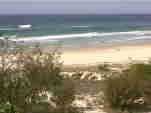|
Sand dunes
The information presented here has been written by Ted Brambleby, Adventure Education,
Marine Environments Field Study and Resource Centre, Hastings Point Beach, NSW
| Take time to observe your skin under a magnifying glass then ask yourself why the familiar yet strange landscape of interconnecting valleys, tall leafless trees and deep salt pits is so vital to the life we know. For one thing it prevents us from dying up. Secondly it allows the workings of the inner body to proceed in a protected stable environment. Thirdly it protects the vital interplay of tissues, rivers of blood, masses of muscle and electric cables of nerves from infection by parasites, Bacteria and viruses, which if not for the skin, would reduce us to sickness, death and dust in a very short time. Think how vulnerable a burns victim is when their skin is destroyed. Why is this? |
 |
Next time you stand on a beach look at the mesmerising stretch of white sand disappearing into the distance. The colour of the ocean and the long raised line of vegetation that separates these primordial, harsh seemingly empty environments from the living tapestry of khaki and green protected behind it. Now understand that those "useless" mounds of good for nothing scrawny spreads of vegetation called sand dunes are in real terms invaluable.
To the creative eye these zones in their pristine state can convey some of the most starkly beautiful and artistically inspiring images on earth. Our coastal dunes are in fact the very skin that serves not only to protect our landward eco systems from the ever present ravages of beach and ocean but provides the very basis for their origin and evolution of our coastal forest heritage. Their natural capacity for repair and re newel like sharks teeth "a skin derivative" are continuous and non exhaustive.
|